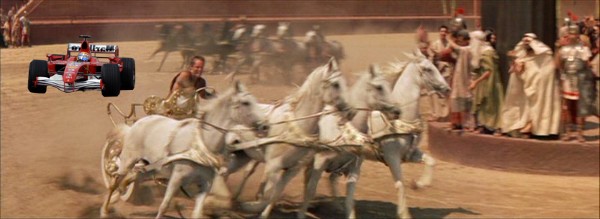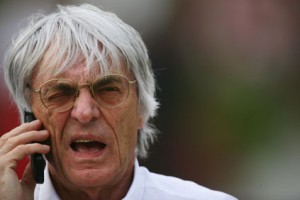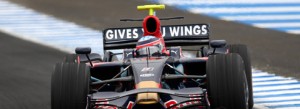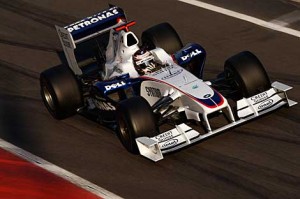December 31st, 2008
David
 2008 saw some controversial decisions by the stewards with the most controversial being the decision to strip Lewis Hamilton’s win in the Belgian Grand Prix and in so doing hand the victory to Filipe Massa. After watching one of the most exciting races of the year fans then discovered two hours later that the stewards had applied a 25 second penalty to Hamilton’s time and he wasn’t in fact the winner. Niki Lauda called this “the worst judgment in the history of Formula One” and there were many calls for changes to the way stewarding worked to try to increase the transparency and consistency of decisions. Three-times championship winner Sir Jackie Stewart said:
2008 saw some controversial decisions by the stewards with the most controversial being the decision to strip Lewis Hamilton’s win in the Belgian Grand Prix and in so doing hand the victory to Filipe Massa. After watching one of the most exciting races of the year fans then discovered two hours later that the stewards had applied a 25 second penalty to Hamilton’s time and he wasn’t in fact the winner. Niki Lauda called this “the worst judgment in the history of Formula One” and there were many calls for changes to the way stewarding worked to try to increase the transparency and consistency of decisions. Three-times championship winner Sir Jackie Stewart said:
its being overseen by people who are not doing it full-time and we get inconsistent decisions. In football, rugby, tennis or cricket you have professional referees and umpires who do their jobs day in, day out and you have accountability. We need that in motorsport.
It seems the FIA has taken these criticisms on board and in a meeting on 5 November 2008 the World Motorsport Council agreed the following changes:
- Any national steward participating who is officiating for the first time will be required to observe a minimum of one Grand Prix prior to their event.
- At five Grands Prix in 2009, a number of trainee Stewards, nominated by their ASN and selected by the FIA, will be invited to attend.
- Before each Grand Prix, a short CV of each steward will be posted on the FIA website.
- With the benefit of a new replay system available to the stewards, all incidents will be investigated and appropriate action taken during the race, unless it is essential to seek further evidence afterwards.
- Following the race, a short written explanation of stewards decisions will be published on the FIA website. This will supplement the formal stewards decision which largely defines the breach of the rules.
- Where appropriate, additional film evidence that the public may not have seen but which was reviewed by the stewards, will be made available on both the FIA and FOM websites.
Hopefully these changes will bring a consistency and transparency to the stewards decisions in 2009. In particular it seems we won’t have any more outcomes being changed after the conclusion of the race. In what is already one of the most highly regulated sports the emphasis should be on the wheel-to-wheel racing not on the rules. Obviously rules are necessary and if they are broken then appropriate penalties should be applied but we don’t want a situation where drivers are afraid to make a racing move because they don’t know if they will be penalised later.
Consistency of decisions will also help to dispel the conspiracy theories about Ferrari’s special place in F1 (even if they do make for some funny jokes.)
December 28th, 2008
David

Ferrari president Luca Di Montezemolo has said he wants more “real tracks” instead of the new “tourist tracks” like Singapore and Valencia:
Having two or three Monte Carlos is too much. Next time we can race inside the Coliseum, or maybe inside the Papacy. This is not racing.
Now as awesome as F1 cars racing around the Coliseum sounds (preferably with spikes on the wheels) I do agree to a certain extent. Luca makes a good point when he says “we need to improve competition, so that the racing is good not only when it rains or the Safety Car creates a situation.” How many times in 2008 did a fairly average race suddenly become more exciting because of wet weather? The opportunity for exciting racing has to be the main consideration when choosing where to go racing.
I don’t agree with Di Montezemolo’s opinion of the Singapore Grand Prix, though. I thought this was a fantastic event. The cars looked awesome under the lights and there was real excitement watching the way the drivers dealt with the slippery surface. Now that most teams use those ugly wheel covers that hide the glowing disc brakes it was nice to see flames spitting from the exhaust in the low light. I’m sure Ferrari’s poor performance in Singapore has nothing to do with his dislike of the circuit…
But just because Singapore worked doesn’t mean we should suddenly start adding night races everywhere. This would detract from the specialness of Singapore. In fact I would be happy for Singapore to remain the only night race on the calendar. Monaco is special because of its history. But it is also special because there is no other race like it.
December 21st, 2008
David

It was Andrew’s suggestion that I write a regular post covering the latest crazy thing to come out of F1 supremo Bernie Ecclestone’s mouth. Whether it’s saying that Honda’s departure was “no great loss” or suggesting some new medals scheme instead of points, you just know it won’t be long before the 5′ billionaire says something controversial.
This week the Times reports that, responding to Ferrari boss Luca Di Montezemolo’s remark that the sport did not need a dictator, Bernie put an actual figure on the extra money that Ferrari get over the other teams:
The only thing he has not mentioned is the extra money Ferrari get above all the other teams and all the extra things Ferrari have had for years the general help they are considered to have had in Formula One
He went on:
They know exactly what they get, they are not that stupid, although they are not that bright, either. They get about $80 million (about £54 million) more. When they win the constructors championship, which they did this year, they got $80 million more than if McLaren had won it.
Personally, I like the little dictator. I always enjoy Martin Brundle’s interviews with him on his pit walks. Bernie never seems quite sure where he is or what he’s meant to be doing.
December 10th, 2008
David
 Takuma Sato put in the second fastest time in the Toro Rosso in testing at Jerez today; a little over half a second behind new guy Sebastien Buemi although Sato did it in only 38 laps whereas the Swiss driver had 128 laps to get his eye in. Sebastien Bourdais was third fastest.
Takuma Sato put in the second fastest time in the Toro Rosso in testing at Jerez today; a little over half a second behind new guy Sebastien Buemi although Sato did it in only 38 laps whereas the Swiss driver had 128 laps to get his eye in. Sebastien Bourdais was third fastest.
I hope Sato gets a place at Toro Rosso in 2009. Sure, he had a reputation as a bit of a crasher but that’s what made him so fun to watch. You were never sure when Taku was going to try some crazy banzai move up the inside of someone, probably his team mate.
 2009 will see some of the biggest regulation changes in Formula Ones history. Along with the introduction of the new KERS technology almost every aerodynamic part will be affected. So what exactly is changing? Well, you can read the full 63 page FIA document, but here’s a summary of the main changes:
2009 will see some of the biggest regulation changes in Formula Ones history. Along with the introduction of the new KERS technology almost every aerodynamic part will be affected. So what exactly is changing? Well, you can read the full 63 page FIA document, but here’s a summary of the main changes:
- Slick tyres
- In an attempt to control the ever-increasing speeds in Formula One, slick tyres were banned in 1998. Due to developments in other areas though this had a limited affect and 2009 will see the re-introduction of slicks to Formula One. It’s about time.
- Aerodynamics
- There have been big aerodynamic changes made in an attempt to promote overtaking. The rear wing is much higher and narrower while the front wing is lower and wider. All the amazing little deflectors, hydrofoils and flick-ups that the cars have sprouted over the last season will be removed. According to McLaren’s Director of Engineering, Paddy Lowe, when the ’09 car first went into the wind tunnel they had lost over 50 per cent of downforce. While removing some of the appendages like the “horns” that Honda used will improve the look of the cars I can’t help thinking the new wings make them look just a bit less pretty. Maybe I’m just not used to it yet and if it helps following cars to get close enough to overtake more then that can only be a good thing.
- Kinetic Energy Recovery System (KERS)
- These devices store energy created under braking. This energy can then be converted into power at the touch of a button giving a short boost of up to 80hp. There are two types of KERS systems; one which uses a flywheel (storing mechanical energy) and one using a battery or supercapacitor (storing electrical energy). These won’t be compulsory in 2009 so it may be that some teams at least start the season without the technology especially considering the incidents that some teams have had; Red Bull had a fire in their factory caused by a KERS device and a BMW Sauber mechanic was given an electric shock when he touched a KERS-equipped car in testing at Jerez.
- Engines
- From 2009, engine life will be extended from two to three races however FIA President Max Mosley is now also pushing plans to introduce standardised engines in 2010, possibly supplied by Cosworth. This cost-cutting move has been criticised by drivers and teams alike with both Fernando Alonso and Ferrari saying they could quit if a standard engine was introduced. Teams have until this Thursday to notify the FIA if they want to use the Cosworth engine. I doubt any will take up the offer.
- Team budgets
- Rather than trying to constrain the teams’ spending through ever more regulations, the FIA has decided to just put a cap on expenditure for all Formula One costs other than engines, drivers and expenditure exclusively for promotion and marketing. The expenditure for the 2009 season will be capped at $268 million. This will drop to $214 million in 2010 and finally settle on $170 million from 2011. This is significantly less than the $400 million or so the biggest teams spent in 2008.
- Driver Adjustable Bodywork
- This is an intesting one. Article 3.18 of the Regulations states “A single closed section situated each side of car centre line… is allowed to change incidence while the vehicle is in motion within a maximum range of 6 degrees… a maximum of two adjustments may be made within any single lap of a circuit”. So a driver can take some wing off for more speed in the straights and add some wing for the corners. But only twice per lap. I’m not sure what the point of limiting the number of adjustments per lap is. It just seems to make what seems a fairly complicated setup even more so.
Will these new regulations lower costs and increase overtaking? It remains to be seen. Decreasing the aerodynamic downforce takes away some grip but the slick tyres give significantly more grip than the grooved tyres of 2008 so really it’s a move away from aerodynamic grip towards mechanical grip. Will they just cancel each other out?
A cap on budgets will obviously lower costs but I think a standardised engine is a bad move. It’s not just the best drivers competing on the track that makes Formula One special, it’s also the best engineers competing in the factory to produce the fastest car. Similar to the crazy situation we had in 2005 when tyre changes were banned, if we take away this part of the sport it actually becomes less interesting not more.
I don’t think we’ll really know how successful the changes have been until we get to Melbourne.
 2008 saw some controversial decisions by the stewards with the most controversial being the decision to strip Lewis Hamilton’s win in the Belgian Grand Prix and in so doing hand the victory to Filipe Massa. After watching one of the most exciting races of the year fans then discovered two hours later that the stewards had applied a 25 second penalty to Hamilton’s time and he wasn’t in fact the winner. Niki Lauda called this “the worst judgment in the history of Formula One” and there were many calls for changes to the way stewarding worked to try to increase the transparency and consistency of decisions. Three-times championship winner Sir Jackie Stewart said:
2008 saw some controversial decisions by the stewards with the most controversial being the decision to strip Lewis Hamilton’s win in the Belgian Grand Prix and in so doing hand the victory to Filipe Massa. After watching one of the most exciting races of the year fans then discovered two hours later that the stewards had applied a 25 second penalty to Hamilton’s time and he wasn’t in fact the winner. Niki Lauda called this “the worst judgment in the history of Formula One” and there were many calls for changes to the way stewarding worked to try to increase the transparency and consistency of decisions. Three-times championship winner Sir Jackie Stewart said:


